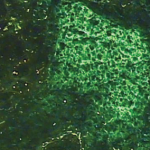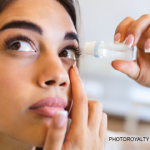Differences Between Children & Adults
While most adults with Sjögren’s syndrome present with features of dryness, children are less likely to come to medical attention with dryness complaints, and fewer children have dry eyes and/or mouth at diagnosis than adults. Parotitis is more common in children, occurring in approximately 60% (compared with less than 25% in adults).3 Other features reported more commonly in children include fevers, lymphadenopathy and positive antibodies (ANA, anti-SSA and/or anti-SSB, and RF).3-7 Beyond glandular manifestations, systemic or extra-glandular manifestations are more common in children, reported in 84–90% of children compared with 26–71% of adults.
The first challenge to diagnosis [of Sjögren’s syndrome] is recognizing the disease can occur in children of any age.
Glandular Manifestations
Parotid gland enlargement is the most common presenting symptom in children with Sjögren’s syndrome. The parotid gland enlargement can be unilateral or bilateral. It can develop as a chronic manifestation or as recurrent acute exacerbation. Even though the parotid gland is the most likely gland involved, submandibular and lacrimal glands can also be involved. At times parotid swelling may be the only presenting symptom in children. In these cases, careful evaluation into other causes of parotid swelling must be considered.
Sicca symptoms are rarely the presenting problems for children with Sjögren’s syndrome. However, many children have signs and symptoms of oral and ocular dryness.3 It seems like children with Sjögren’s syndrome may have difficulty recognizing and verbalizing their complaints related to sicca symptoms. For that reason, detailed questions should be asked to see if they have sicca symptoms, such as, “Do you feel like you have sand in your eyes?” or “Do you feel the need to drink a lot of water?” or “Do you need to take sips of liquid to help you swallow solid foods?”
Female children with Sjögren’s syndrome also have symptoms of vaginal irritation, such as pruritis and vulvovaginitis. It is estimated that 5% of girls with Sjögren’s syndrome suffer from vaginal irritation.2 Additionally, this symptom is likely under-reported in children and adolescents.
Extraglandular Manifestations
Children with Sjögren’s syndrome can have a wide range of differing extra-glandular manifestations. Lymphadenopathy, fatigue, fever and weight loss are characteristic findings in children with Sjögren’s syndrome and tend to occur more often during flares of active disease.8
Neurologic manifestations occur and can affect the central and peripheral nervous system. These manifestations may include peripheral neuropathy, autonomic neuropathy and meningoencephalitis. An association of Sjögren’s syndrome and neuromyelitis optica has been seen in childhood presentations.9
Around one-fifth of children with Sjögren’s syndrome have renal involvement, such as renal tubular acidosis, nephrocalcinosis or renal insufficiency.10
Children can also develop multiple cutaneous manifestations, such as purpura, annular erythema and cutaneous lupus.
Hematologic manifestations, such as autoimmune cytopenias and polyclonal hypergammaglobulinemia, can be seen in children with Sjögren’s syndrome.
Pulmonary manifestations are rare, but have been reported. They include interstitial and restrictive lung disease, and pulmonary hypertension.11
Gastrointestinal manifestation may occur in children with Sjögren’s syndrome and may present as hepatitis or gastritis.

